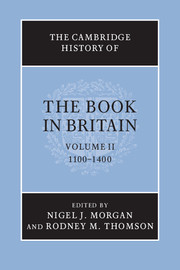Book contents
- Frontmatter
- Preface
- The roles of books
- Book production
- 3 The format of books – books, booklets and rolls
- 4 Layout and presentation of the text
- 5 Technology of production of the manuscript book
- I Parchment and paper, ruling and ink
- II Illumination – pigments, drawing and gilding
- III Bookbindings
- 6 Handwriting in English books
- 7 Monastic and cathedral book production
- 8 Urban production of manuscript books and the role of the university towns
- Readership, libraries, texts and contexts
- List of abbreviations
- Bibliography
- Photo credits
- General index
- Index of manuscripts
- Plates 1
- Plates 2
- References
I - Parchment and paper, ruling and ink
from 5 - Technology of production of the manuscript book
Published online by Cambridge University Press: 28 November 2008
- Frontmatter
- Preface
- The roles of books
- Book production
- 3 The format of books – books, booklets and rolls
- 4 Layout and presentation of the text
- 5 Technology of production of the manuscript book
- I Parchment and paper, ruling and ink
- II Illumination – pigments, drawing and gilding
- III Bookbindings
- 6 Handwriting in English books
- 7 Monastic and cathedral book production
- 8 Urban production of manuscript books and the role of the university towns
- Readership, libraries, texts and contexts
- List of abbreviations
- Bibliography
- Photo credits
- General index
- Index of manuscripts
- Plates 1
- Plates 2
- References
Summary
Right through our period even the humblest books were relatively expensive items, luxury books with illumination astronomically so. This was because even the most basic materials of book manufacture were themselves expensive, and their preparation involved considerable and skilled labour. Cheapness, and therefore availability to a wider market, could only be achieved, from c.1300 by the use of paper rather than membrane for writing on, and at all times by writing small and heavily abbreviated script so as to cram the maximum amount of text into the smallest number of leaves.
The preferred writing material, however, was always membrane (parchment), that is the skin of sheep or calves (vellum), virtually indistinguishable, carefully prepared in a way more or less standard over time and all over Europe. The skin of these animals, when appropriately trimmed, yields a rectangle of approximately the same size and proportions, thus determining both the size and shape of the books made from it. Folded once, the sheet will produce a bifolium (double page) of the largest format (folio), used sparingly, for grand books such as the great illuminated Bibles of the twelfth century, and for Missals and noted service-books at the end of the period. The leaves of these largest of books measure some 500–600 × 350–425 mm. Folding twice produces four leaves (two bifolia) of quarto format (c. 250–350 × c. 150– 250 mm), the norm at all times but especially for the standard monastic books of the twelfth century; later the proportion of smaller books, produced by folding the original skin one more time (producing eight leaves, octavo) becomes greater.
- Type
- Chapter
- Information
- The Cambridge History of the Book in Britain , pp. 75 - 84Publisher: Cambridge University PressPrint publication year: 2008
References
- 3
- Cited by



